Items tagged with 'environment'
Follow up: Radix Center
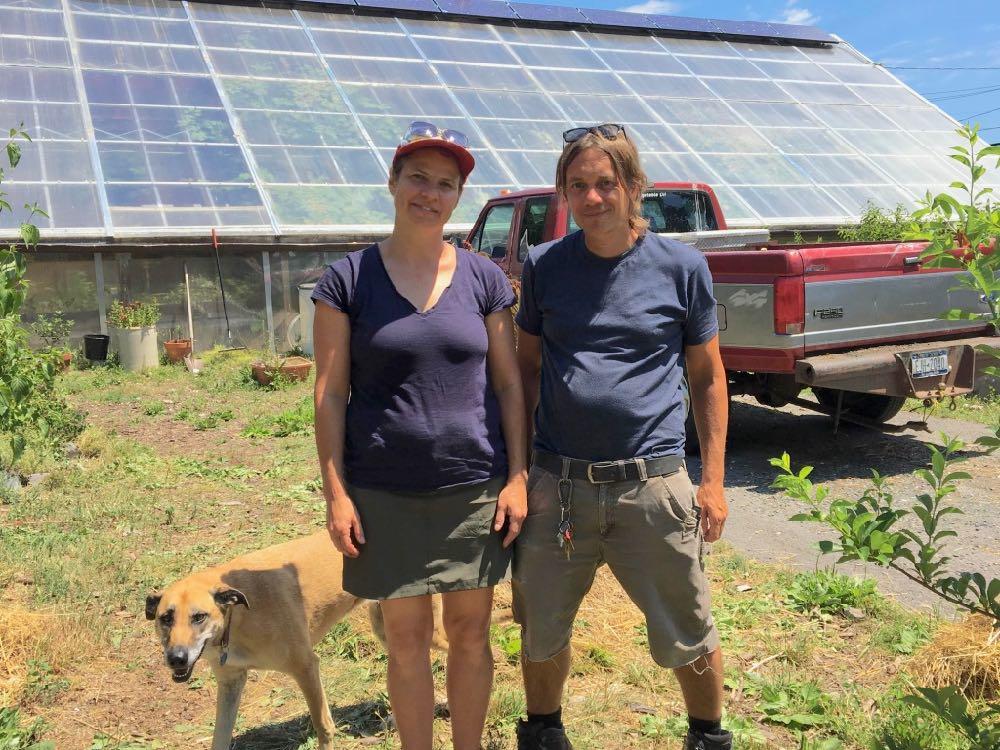
Stacy Pettigrew and Scott Kellogg outside the greenhouse at Radix.
AOA is on summer break. So we'll have new follow-ups with people we've met and covered during the last year.
A little more than seven years ago Scott Kellogg and Stacy Pettigrew won the very first AOA Start Up Grant competition with their plans for an aquaculture to grow fish and watercress at the [then] new Radix Center for Ecological Sustainability. They were in the midst of constructing an 18-foot greenhouse on a corner of Grand Street in Albany's South End.
Almost a decade later the greenhouse is overflowing with plants, they're selling fish and watercress, running a composting business, raising animals, partnering with neighborhood organizations, and teaching students and city dwellers about their connection to nature -- all while raising two daughters and working on their PhDs.
And still, they found time to talk with us about how things at Radix are going.
There's a new type of tick in New York State
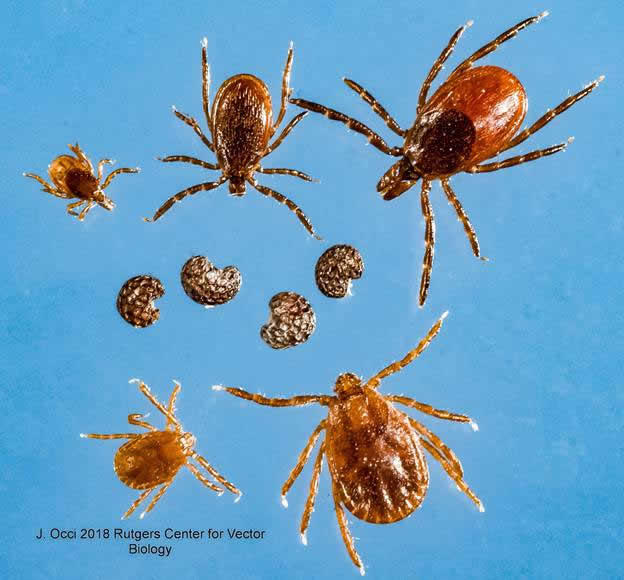 There's a new type of tick in New York, the state Department of Health announced Tuesday: Haemaphysalis longicornis -- the "longhorned tick." DOH says it was found in multiple locations in Westchester County. From the press release:
There's a new type of tick in New York, the state Department of Health announced Tuesday: Haemaphysalis longicornis -- the "longhorned tick." DOH says it was found in multiple locations in Westchester County. From the press release:
While the longhorned tick has transmitted disease to humans in other parts of the world, more research is needed to determine whether this can happen in the United States. Regardless, New Yorkers should continue to take steps to protect themselves, their children and their pets against ticks and tickborne diseases that are present in New York State.
This tick is also a concern for the New York State agricultural industry and may pose a threat to livestock. Farmers should continue to work with their veterinarians to check their animals, particularly cattle, sheep and horses, for exposure to ticks and to ensure their parasite control plans are up to date and working. Symptoms of tick-borne disease in cattle include fever, lack of appetite, dehydration, weakness and labored breathing.
That photo on the right compares deer ticks (top) and longhorned ticks (bottom) with poppy seeds (middle) for scale. (Click on the photo for a larger version -- we figured no one needed to see that up close unless they wanted to.)
The High Peaks are crowded, so the DEC would like to promote "sustainable tourism" in the Adirondacks
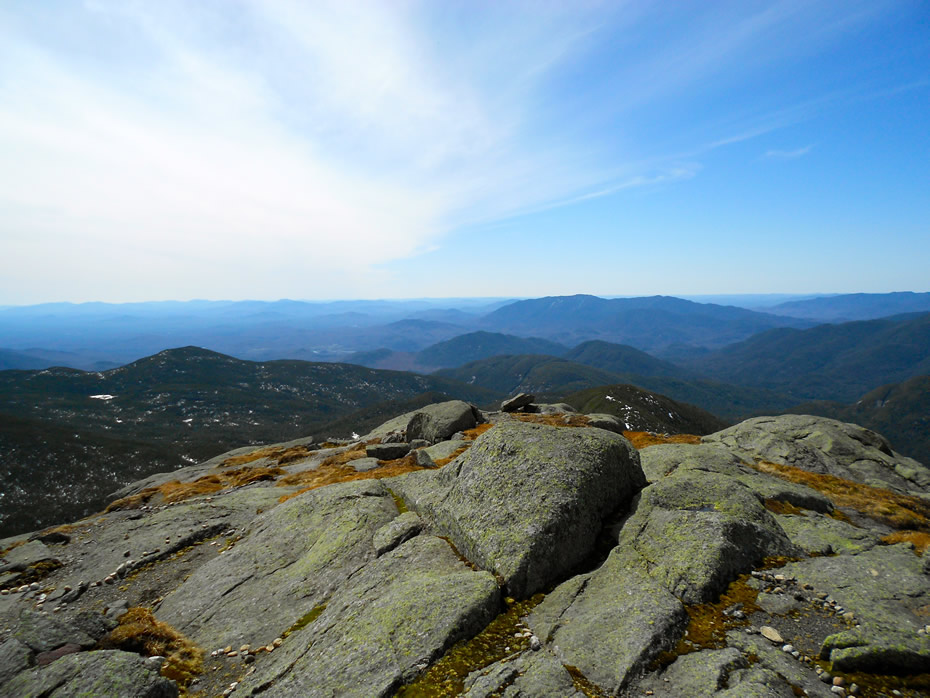
The summit of Mt. Marcy. / photo: Casey Normile
The Adirondacks -- the High Peaks especially -- have been a very popular spot for hikers over the last decade or so. And that's resulted in all sorts of related issues, from crowding to trash to parking problems.
This week the state Department of Environmental Conservation announced it's taking up "a multi-year, comprehensive effort to promote sustainable tourism, and address public safety in the Adirondacks." Press release blurbage (emphasis added):
Popular destinations on DEC lands within the Adirondack Park such as the High Peaks, Dix, Giant and Hurricane Wildernesses, Baxter Mountain, and the Saranac Lake 6'er peaks, are attracting an unprecedented number of users.
To improve public safety and reduce impacts to natural resources in the area, DEC held four focus group meetings this past winter to generate ideas and information to support recommendations, particularly to address overuse challenges in the High Peaks region and the Route 73 corridor between Exit 30 of the Northway and Lake Placid in the Adirondacks. The meetings were held in partnership with the towns of Keene and North Elba and involved a wide range of stakeholders. With input from DEC land managers, the meetings helped the agency identify specific strategies and actions to be taken in 2018 and 2019.
Actions along the Route 73 corridor are scheduled to start during the July 4th holiday week and are being implemented with state agency partners and municipalities. The first phase of actions include:
A very animated explainer about ticks
This might not be the claymation that we want, but it's the claymation that we need.
The clip embedded above is a short claymation explainer about the life cycle of black-legged ticks and ways to protect yourself against them. It's from the New York State Integrated Pest Management program, which is associated with Cornell and the Cornell Cooperative Extension.*
Ticks and the diseases they carry are a big problem in this part of the country. And just last week the Cuomo admin a announced a new round of increased efforts to address the proliferation of ticks and the diseases they spread, such as Lyme.
But back to the video clip... It was created by Max Helmberger, an entomology grad student. Here's a Cornell news article about his work. And, yep, he has more claymation science videos on Youtube.
* Integrated pest management is a fascinating topic. It's basically about how humans can better deal with things like insects and weeds and plant diseases in ways that hurt the environment as little as possible.
Spotting the spotted lanternfly

There is an insect called the spotted lanternfly. It's an invasive species here in the United States. And the state Department of Environmental Conservation would like you to report if you see one around here.
DEC reasons blurbage (emphasis added):
SLF pose a significant threat to New York's agricultural and forest health. Adults and nymphs use their sucking mouthparts to feed on the sap of more than 70 plant species. This feeding by sometimes thousands of SLF stresses plants, making them vulnerable to disease and attacks from other insects. SLF also excrete large amounts of sticky "honeydew," which attracts sooty molds that interfere with plant photosynthesis, negatively affecting the growth and fruit yield of plants. New York's annual yield of apples and grapes, with a combined value of $358.4 million, could be impacted if SLF enters New York. The full extent of economic damage this insect could cause is unknown at this time.
Although native insects also secrete honeydew, the size of SLF and the large populations that congregate in an area result in large accumulations of it. The sticky mess and the swarms of insects it attracts can significantly hinder outdoor activities. In Pennsylvania, where SLF populations are the densest, people can't be outside without getting honeydew on their hair, clothes, and other belongings.
Ew. Also: the term "sucking mouthparts."
An end for plastic shopping bags in New York?

Paper or... reusable?
On Monday the Cuomo admin floated a bill that would ban many kinds of plastic shopping bags starting at the beginning of 2019. Bill language blurbage:
This prohibition does not apply to (i) a reusable bag that is not made of film plastic or a compostable bag; (ii) a plastic bag used solely to contain or wrap uncooked meat, fish, or poultry; (iii) a plastic bag used by a customer solely to package bulk items, such as fruits, vegetables, nuts, grains, or candy; (iv) a plastic bag used solely to contain food sliced to order; (v) a plastic bag used solely to contain a newspaper for delivery to a subscriber; (vi) plastic bags sold in bulk; (vii) a plastic bag prepackaged for sale to a customer including, but not limited to, a trash bag and a food storage bag; (viii) a plastic garment bag; (ix) a plastic bag provided by a restaurant, tavern or similar establishment to carry out or deliver food; or (x) any other bag exempted by the department in regulations.
The bill would also make the state the sole jurisdiction for regulating the use of plastic bags. There are currently a handful of municipalities around the state already with laws on the books. (And the state already requires larger retailer to collect plastic bags for recycling.)
The State Museum coyote is free
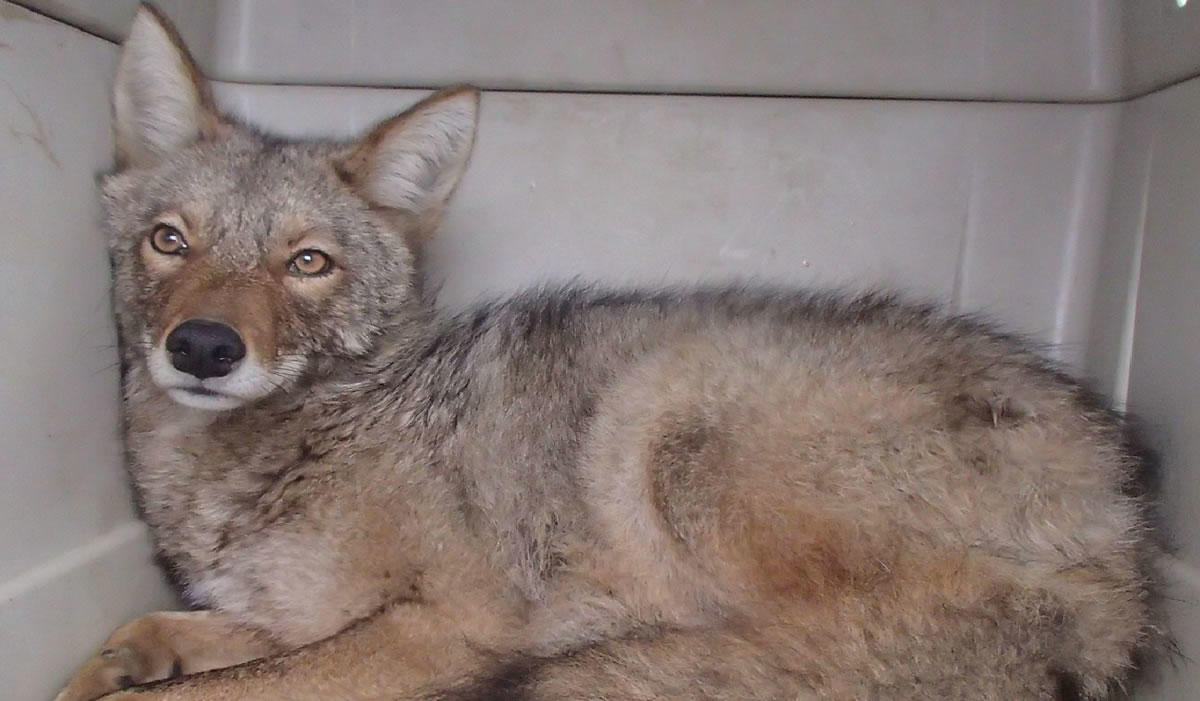
The coyote ahead of its release back into the wild. / photo: NYS DEC
Good news: The state Department of Environment Conservation says the coyote removed from the State Museum terrace Tuesday has been released back into the wild. There's a photo and video from the release below.
DEC says biologists at the agency's Wildlife Health Unit in Delmar checked out the coyote before the release Wednesday morning and concluded the animal was in good health.
As we noted yesterday, it's not all that surprising that a coyote would turn up around the Empire State Plaza -- they slip through urban and suburban areas often. But finding one hanging out in a place like that during the day is odd. So what happened?
There was a coyote at the State Museum

A photo posted by NYS Police on Twitter Tuesday.
A thing that happened Tuesday: A coyote -- an actual, living, wild coyote -- found its way up onto the terrace of the State Museum around noon.
State Police responded, and in turn called in the state Department of Environmental Conservation. DEC said that wildlife technicians tranquilized the coyote and took the animal to the agency's wildlife lab for evaluation. A DEC police lieutenant told the media it's not clear if the coyote was sick, but it had been become trapped and was scared. [@nyspolice] [@NYSDEC] [@bern_hogan]
Let's hope the coyote avoids the usual ending to the wild animal story arc. (RIP, Runaway Bison and Albany Bear.)
Coyotes among us
That a coyote would show up around the State Museum -- or anywhere in Albany -- is actually not that surprising. That it would end being noticed is more so.
Solar Energy for Everyone info event

A group of environmental and renewable energy orgs are sponsoring a "Solar Energy for Everyone" event March 28 at East Greenbush Methodist Church. Poster blurbage:
Learn about solar options:
1. Install solar panels on your home, property or business
2. Choose a renewable energy electricity supplier
3. Buy or lease solar panels at a community farm
PowerPoint presentation on Community Solar. High Peaks Solar, Hudson Solar and Monolith Solar will be present to answer questions about their community solar farms and onsite solar installations for NYSEG and National Grid customers. You will be able to sign up for a renewable energy electricity supplier.
The event is Wednesday, March 28 from 6:30-8:30 pm. The East Greenbush Methodist Church is at 1 Gilligan Road.
Getting solar panels for your home could be a lot more affordable than you might think. The price of solar panels has been dropping quickly in recent years. And tax credits from the federal government and New York State can cover more than half the cost. Depending on the circumstances -- size of system, location, electricity usage -- the pay back can be in the 6-7 year range.
If you're thinking about getting solar, it's worth checking in with the Solarize Albany group, which offers information about sorting through options and organizes group buying discounts. Its upcoming 2018 campaign will include a focus on solar for affordable housing.
The return of the blue snowflakes
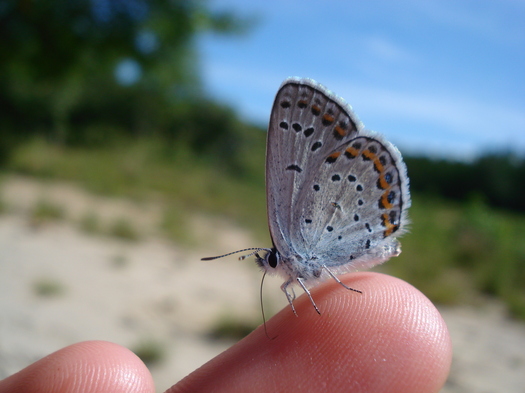
The Albany Pine Bush is an unusual example of an inland pine barrens, and it's one of the few homes to an unusual inhabitant: The tiny, beautiful -- and endangered -- Karner Blue butterfly. And it's making a comeback.
The Albany Pine Bush Preserve Commission announced Thursday that conservation efforts in recent decades have apparently had a big effect on Karner Blue populations in the Pine Bush. In 2007, the preserve was estimated to have fewer than 1,000 of the butterflies. And in 2016: more than 15,000.
Spring is back, and so are ticks (ugh)

The average annual number of reported Lyme disease cases by county between 2011-2015. (Please see the important notes below about these numbers.)
This part of the country -- the whole Northeast, really -- is a hot spot for Lyme disease. The map* above depicts the average number of Lyme cases** reported in each county each year between 2011-2015 -- the numbers are published by the federal Centers for Disease Control and Prevention.
There's a larger, clickable national map after the jump if you'd like to explore further.
New York is tagged as a "high-incidence state" for Lyme by the CDC -- it had the 13th highest rate of confirmed cases per 100,000 people across the three years 2013-2015. (Vermont had the highest rate, and Massachusetts the fifth.)
Here's info from the state Department of Health of ways to lessen the risk of being bitten by a tick and what to do if you are. (And don't forget about taking precautions for your dog, too!)
Adapting for a more extreme future

Flash flooding in the city of Albany in 2014 when a storm dropped almost three inches of rain in less than an hour. / photo via Laura (thank you)
The Northeast US is looking at average temperature rises of a few degrees over the next century because of climate change, according to the some of the best estimates. And while an increase of, say, 4 degrees might not sound like much, it's setting up a future in which the extremes are likely to be more extreme and more common: hotter heat waves, bigger rainfall events, more common floods.
Radley Horton, a climate scientist at Columbia University's Center for Climate Systems Research, was at UAlbany this week for a program about extreme events prompted by climate change and their effects on human health.
We got a chance to talk with him for a few minutes about how climate change is already affecting this part of the country, what could be ahead, and how we might adapt.
But if there were mountain lions here...

For hire? / photo: Greg Hume (CC BY-SA 3.0) via Wikipedia
An interesting thing about the way the landscape of the Northeast has been changing over the last century is that the amount of forested land has actually increased as many areas that were once cleared for farming have fallen back into being covered by trees.
These new forests aren't exactly like the old forests, though. Among the differences: they lack some of the large predators of the past -- notably cougars/mountain lions and wolves. That might not seem like a big deal for humans -- it might even seem like a good thing, considering those sorts of animals can be a bit fear inducing. But one of the side effects is that deer now lack a natural predator, and their populations have exploded.
There are so many deer. And they cause all sorts of problems -- from car crashes, to disease transmission, to habitat destruction, to grazing on gardens.
So. If we could get some of these predators back in this area -- mountain lions, specifically -- what might that be worth?
A peek at our possible future climate

A screengrab of the Climate Explorer map that allows you see projected rainfall change under two different emissions scenarios. This map is showing projected rainfall for the Northeast January in 2050. (The deeper the green, the larger the project rainfall increase from the 1960-1989 normal.)
We've had an unusually dry summer so far, and it's been somewhat hotter than usual, too. And while any one year isn't necessarily a sign of some broader trend, this summer is in some ways an example of what the future summers here might be like because of climate change.
We were thinking about that today while looking around the federal government's new Climate Explorer website. It takes projections based on climate change models and greenhouse gas emission scenarios and makes them easy to map and graph for locations around the country. For example: Here's the page for Albany County.
So, what sort of future are the models pointing toward for our area?
What, your job doesn't involve baby bears?

Oh, hello, there...
Filed under "jobs we didn't know existed" and "the cuteness is too much": Biologists with the state Department of Environmental Conservation have been visiting bear dens around the state to gather data about bear populations in New York. And that process involves (temporarily) removing bear cubs from the dens so they can be weighed.
This week the DEC posted photos from one of these recent den visits -- in Allegany State Park -- on its Facebook page. That's one of the pics above. A clip from the post:
The 173-pound sow was ear-tagged and fitted with a GPS tracking system collar. The collar collects GPS points at set intervals, then sends the location via text messages - so even bears are getting in on texting these days! DEC staff carefully monitored the sow's vitals during the process. The bandana is used to protect her eyes while she is immobilized.
During this time, the three cubs were ear-tagged and weighed only. There were 2 males and 1 female bear cub. The cubs were fairly small (3-4 pounds each) and healthy, probably meaning they were born in late January. After the work was done, the sow is placed back in the bear den with her cubs, where they will stay until the cubs are big enough to keep up with their mother in the woods, typically another few weeks.
DEC says it will be sharing more from these bear den visits over the next week.
Black bear populations in New York State have "increase[d] dramatically in number and distribution in recent decades," according to state's Black Bear Management Plan published in 2014 -- and there are now more than 6,000 bears estimated to be in the state, across large portions of upstate.
Earlier on AOA:
+ Don't feed the bears
+ There's a moose... and there's a moose... and there's a moose...
photo: NYS DEC
Signs of a comeback for one of the Hudson River's iconic species

illustration: Duane Raver/U.S. Fish and Wildlife Service via Wikipedia
The Atlantic sturgeon is an iconic species for the Hudson River -- it's the fish depicted in the logo for the river's estuary, it was once a favorite food in this area known as "Albany beef," and they can grow up to 8-feet-long. The last century has been rough on the species, though -- the population has declined significantly the fish are now considered endangered.
But the state Department of Environmental Conservation reports this week that there are indications that Atlantic sturgeon populations are rebounding. DEC says a survey of the Hudson River last year found the highest numbers of sturgeon in the survey's 10-year history -- and there appears to be an overall upward trend.
Said acting DEC commissioner Basil Seggos in a press release: "We are cautiously optimistic that, with our continued vigilance and efforts to protect this species, Atlantic sturgeon will have a secure future."
The decline of Atlantic sturgeon populations prompted a 1998 moratorium on fishing them along the East Coast. And that ban could last until the late 2030s because sturgeon can live as long as 60 years, and don't reach maturity until 11-21 years old.
As David Strayer, a freshwater ecologist at the Cary Institute of Ecosystem Studies in Millbrook, explained to us last year:
"Fisheries biologists talk about [the overfishing of Atlantic sturgeon] like clear cutting, which I think is an apt analogy. You wouldn't think you could go into a wood lot and cut all the trees every five minutes and expect there to be a forest there any longer. Everybody understands it takes so many years for a baby tree to grow up. It's the same way with the sturgeons. When we started fishing them real hard it was like someone went into the woods and cut all the trees."
And now it appears the forest of fish is starting to slowly grow back.
Earlier on AOA: Odd and notable creatures of the Hudson River
Revisiting the reservoir goats
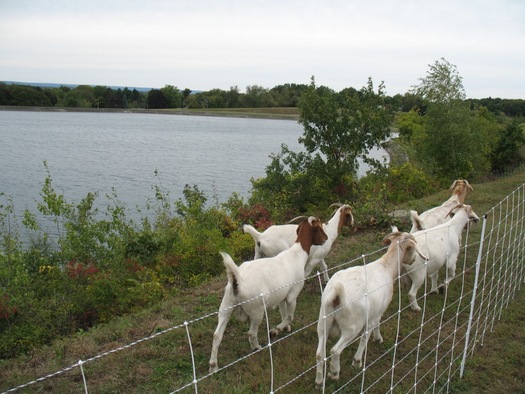
A month ago the Albany Water Board announced it had hired (so to speak) five goats to clear a brush-covered section of the land around the city of Albany's Loudonville Reservoir.
A strip along the eastern edge of the reservoir had become choked with a tangle of trees, bushes, and vines -- and the slope of the land made it hard to work on, especially since debris would have to be kept out of the reservoir. Apparently it was difficult enough that the water board had trouble finding a contractor willing to take on the tricky task.
Enter the five goats from Heather Ridge Farm as a sort of test of the concept of goatscaping.
So, how'd that turn out?
Reservoir goats
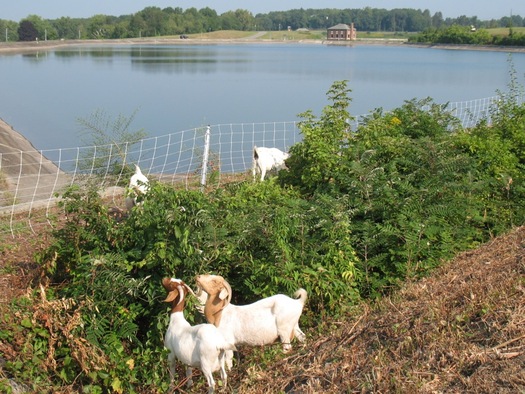
They're working.
It can be hard to hire a contractor. Sorting through all the various options. Coordinating calls and appointments for estimates. Trying to pick the best person.
And what if, as the Albany Water Board recently decided, the best person for the job is... a goat?
Seeing the city for the trees

Albany's city forester says the ash trees in Townsend Park will probably have to be taken down.
Trees are often one of those things you don't really have a real sense of until they're gone. It's remarkable how much emptier, starker, hotter a street can feel after a few longstanding trees are taken down.
The city of Albany is facing the possibility of experiencing this sort of impact on a large scale. Last year an invasive beetle was detected in the city for the first time and the city's ash trees -- of which there more than 2,000 along the city's streets and in its parks -- are threatened with being killed off.
We talked with Albany's city forester, Tom Pfeiffer, recently about dealing with this threat, the problems associated with uniformity, trees that stink, and trees as infrastructure.
A future with less heating, more air conditioning

Can you imagine a New York with temperatures that are more like... Oklahoma?
That's one of the comparisons made in a paper published today in Scientific Reports that aims to project how global warming will affect the heating and cooling needs of areas around the United States.
Using a climate scenario that expects global mean surface temperatures to rise by more than 4 degrees Fahrenheit, two Stanford researchers projected how the current "normal" annual number of heating and cooling degree days across the US would compare to levels at the end of this century.
(You can think of heating and cooling degree days as a measure of how much heating or cooling a building needs in a place over a time period.)
Here's a clip from the paper about projections for New York City:
The historical CDD [cooling degree day] value of New York City (1,105 CDD) is projected to increase by the end of the century (2,348 CDD), approaching a CDD value that historically prevailed in the hot desert climate of El Paso, TX (2,331 CDD). The historical HDD [heating degree day] value (4,750 HDD) in New York City is projected to decrease (3,126 HDD) to approximately the number of HDD in present Raleigh, NC (3,246 HDD). New York City's historical degree-day sum (5,855 HDD + CDD) will decrease (5,474 HDD + CDD), resembling the historical degree-day sum in Oklahoma City, OK (5,463 HDD + CDD).
The researchers used numbers for current normals from more than 7,000 weather stations around the country, so they were able to make maps based on the projections. One of them -- showing projected differences in cooling and heating degree days across the country -- is above.
A bigger map, which we think illustrates things a bit better, is after the jump. And it illustrates that the Albany area is, of course, not exactly like New York City. But the general trend is projected to be about the same -- fewer heating degree days, and a lot more cooling degree days.
Oh, hey, another seal in the Hudson River
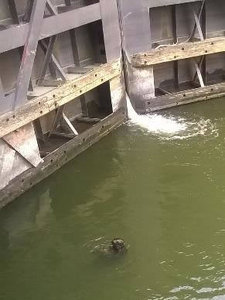 Speaking of unusual Hudson River creatures... the state Canal Corporation reported today that a seal -- yep, a seal -- made its way through the lock at the Federal Dam in Troy this weekend. From the Canal Corp's FB posting (link added):
Speaking of unusual Hudson River creatures... the state Canal Corporation reported today that a seal -- yep, a seal -- made its way through the lock at the Federal Dam in Troy this weekend. From the Canal Corp's FB posting (link added):
We had a special visitor at Lock C-1 (Halfmoon) over the weekend! A seal swam up the Hudson River and locked through the federal lock at Troy before visiting us on the Champlain Canal. Thank you The Riverhead Foundation for Marine Research and Preservation for your guidance as we worked to keep the seal safe.
That photo is also from the Canal Corp's FB posting.
As it happens, it's not really all that usual to see a seal in the Hudson River around Albany. A seal -- or maybe multiple seals -- have been popping up around Coxsackie the last few years. As you know, the Hudson is open to the ocean at its southern end, and the thought is that seals end up here after after following food up river.
(Thanks, Duncan!)
Earlier on AOA:
+ Odd and notable creatures of the Hudson River
+ That time whales swam to Albany
Three environmental issues facing the Hudson River
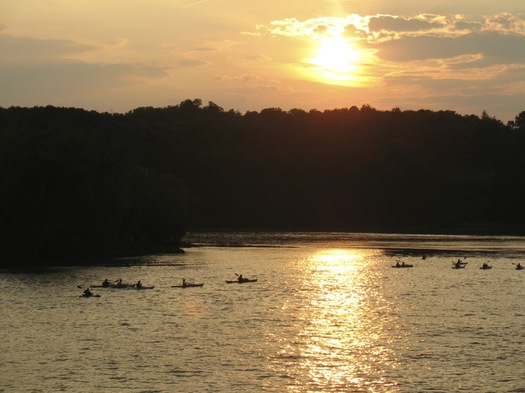
Ahead of the Rail, River, Hudson II tour this coming weekend, we have a series of posts focusing on the Hudson River this week.
As much as the Hudson River has been revered and treasured by people over the years for its beauty and key role in our communities, it's also suffered its share of adverse impacts during that history.
Here's an overview of three significant concerns that environmental orgs flagged about the Hudson River right now.
River Week is sponsored by: Albany County Convention and Visitors Bureau, Downtown Albany BID, Dutch Apple Cruises, Harmony Mills, Hudson River Greenway, Nine Pin Cider, Sweet Sue's, and Downtown Troy BID.
Solar continues to grow around New York
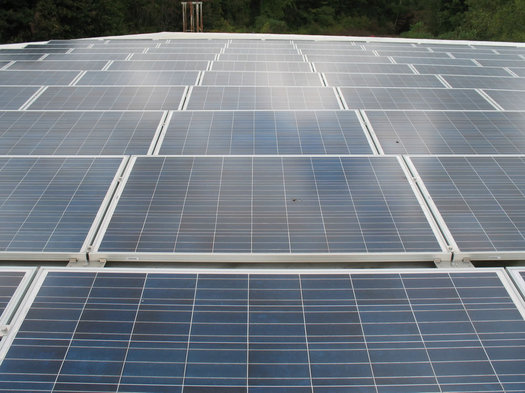
More common.
The Capital Region had the second-highest amount of installed solar energy generation capacity in the state as of 2014, according to numbers released by the Cuomo admin Monday. The eight-county region had 51 megawatts of capacity -- up 500 percent since 2011. (The region with the highest total was Long Island, with 96 megawatts.)
For some perspective, a megawatt of installed solar is estimated to be capable of powering about 155 homes a year in New York State.
New York State has a whole had almost 315 megawatts of installed solar capacity as of 2014, according the Cuomo admin. That's up 300 percent since 2011.
A few individual Capital Region counties also ranked highly. Albany County had 13.66 megawatts of installed capacity -- the fifth-highest total among all counties. And Columbia County ranked #1 for installed capacity per capita.
Are there clickable maps? You know there are...
Some number of facts about the Normanskill

It's a long running thread through this area.
With the Normanskill in the news this week, we thought it'd be interesting to look into the stream's course through this area -- both in geography and history. We started with the intent of digging up one fact or bit for each mile of the Normanskill -- but, frankly, we lost count.
So here is an undetermined number of facts or bits about the Normanskill.
Short commute, small footprint

Among the benefits to living near the Capital Region's urban core: on average, your household probably will have a lower greenhouse gas footprint.
The above map caught our eye while we were flipping through the docs for that Capital District Transportation Committee draft plan for the area's transportation future. It depicts the estimated average greenhouse gas footprint -- for both transportation and household use -- for households in each municipality. (After the jump, we've also clipped the map that depicts estimated greenhouse gas footprints just for transportation.)
The map is probably what you'd expect -- if a municipality, like the city of Albany, hosts a lot of jobs then its residents are more likely to not have to commute far, and as a result, won't have as large a greenhouse gas footprint. (And you'd probably expect the inverse, too.) In fact, that map matches up pretty well with maps for both daytime population swing and average commute time in the region.
We were curious about the estimates behind the map, so we dug out a Capital District Regional Planning
Commission report about a regional greenhouse gas inventory. The estimates are explained on p. 19. And the report also includes more, and larger, maps on the topic.
One highlight from those additional maps: An estimate of energy costs by municipality (p. 23). The difference between the low and high end is about $8,500 per year.


... said KGB about Drawing: What's something that brought you joy this year?